
The Northrop GrummanEA-6B Prowler is a twin-engine, four-seat, mid-wing electronic-warfare aircraft derived from the A-6 Intruder airframe. The EA-6A was the initial electronic warfare version of the A-6 used by the United States Marine Corps and United States Navy. Development on the more advanced EA-6B began in 1966. An EA-6B aircrew consisted of one pilot and three Electronic Countermeasures Officers, though it was not uncommon for only two ECMOs to be used on missions. It was capable of carrying and firing anti-radiation missiles (ARMs), such as the AGM-88 HARM.

Electronic Attack Squadron 135 (VAQ-135), known as the "Black Ravens", is a United States Navy electronic attack squadron that currently operates the EA-18G Growler carrier-based electronic warfare jet aircraft. The squadron is permanently stationed at Naval Air Station Whidbey Island with a radio callsign of "Thunder".

Electromagnetic Attack Squadron 137 (VAQ-137) also known as the "Rooks", is a United States Navy electromagnetic attack squadron based at Naval Air Station Whidbey Island Washington, flying the Boeing EA-18G Growler. The squadron is attached to Carrier Air Wing 11 (CVW-11), which is currently assigned to USS Theodore Roosevelt (CVN-71). Their radio callsign is "Rook" and their tailcode is "NH" of CVW-11.
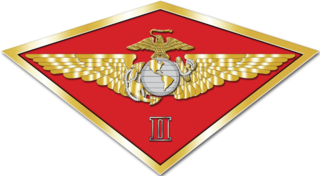
The 2nd Marine Aircraft Wing is the major east coast aviation unit of the United States Marine Corps and is headquartered in Marine Corps Air Station Cherry Point, North Carolina. The Wing provides the aviation combat element for the II Marine Expeditionary Force.

Marine Tactical Electronic Warfare Training Squadron 1 (VMAQT-1) was a United States Marine Corps electronic warfare training squadron consisting of EA-6B Prowler jets. The squadron was based at Marine Corps Air Station Cherry Point, North Carolina and fell under the command of Marine Aircraft Group 14 (MAG-14) and the 2nd Marine Aircraft Wing. The VMAQT-1 logo was the Banshee, an Irish mythological figure foretelling death. Its motto was "Tairngreacht Bas," Gaelic for "Death Foretold."

A carrier air wing is an operational naval aviation organization composed of several aircraft squadrons and detachments of various types of fixed-wing and rotary-wing aircraft. Organized, equipped and trained to conduct modern US Navy carrier air operations while embarked aboard aircraft carriers, the various squadrons in an air wing have different but complementary missions, and provide most of the striking power and electronic warfare capabilities of a carrier battle group (CVBG). While the CVBG term is still used by other nations, the CVBG in US parlance is now known as a carrier strike group (CSG).
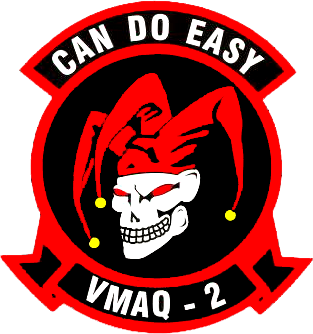
Marine Tactical Electronic Warfare Squadron 2 (VMAQ-2) was a United States Marine Corps electronic warfare squadron in service from 1952 to 2019. It was the last squadron flying the Northrop Grumman EA-6B Prowler.
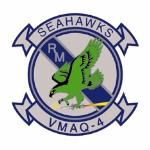
Marine Tactical Electronic Warfare Squadron 4 (VMAQ-4) was a United States Marine Corps electronic warfare squadron consisting of EA-6B Prowler jets. The squadron was last based at Marine Corps Air Station Cherry Point, North Carolina and fell under the command of Marine Aircraft Group 14 (MAG-14) and the 2nd Marine Aircraft Wing. The squadron was decommissioned on 2 June 2017 as the Marine Corps sundowns the EA-6B Prowler.

VMFA(AW)-332 Marine All Weather Fighter Attack Squadron 332 was a United States Marine Corps F/A-18 Hornet squadron. Also known as the "Moonlighters", the squadron was based at Marine Corps Air Station Beaufort, South Carolina as part of Marine Aircraft Group 31 (MAG-31), 2nd Marine Aircraft Wing. The squadron flew its last flight in the F/A-18 Hornet on March 30, 2007. At the time of their deactivation, they held the longest streak of mishap-free flight hours for a tactical jet squadron at 109,000 hours.

Electromagnetic Attack Squadron 142 (VAQ-142), also known as "The Gray Wolves", is an EA-18G Growler squadron of the United States Navy stationed at Naval Air Station Whidbey Island, Oak Harbor, Washington. Their tailcode is AJ and their ATC callsign is "GRIM".

Marine Aviation Logistics Squadron 14 (MALS-14) is an aviation logistics support unit of the United States Marine Corps. They are currently based at Marine Corps Air Station Cherry Point and fall under the command of Marine Aircraft Group 14 (MAG-14) and the 2nd Marine Aircraft Wing.

Marine Tactical Reconnaissance Squadron 3 (VMFP-3) was an aviation unit of the United States Marine Corps active between 1975 and 1990.
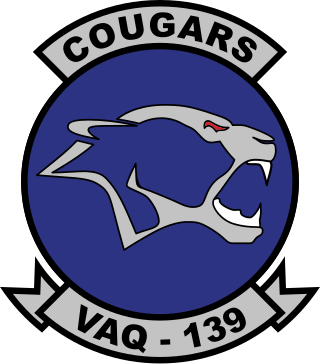
Electromagnetic Attack Squadron 139 (VAQ-139), also known as the "Cougars", is an EA-18G Growler squadron of the United States Navy. They specialize in electromagnetic attack and are currently stationed at Naval Air Station Whidbey Island, Washington. Part of Carrier Air Wing Seventeen, the Cougars deploy aboard the aircraft carrier USS Nimitz
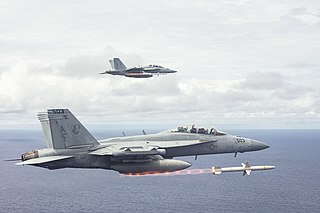
Electronic Attack Squadron 209 (VAQ-209) is a United States Navy Reserve electromagnetic attack squadron. Known as the "Star Warriors", the squadron flies the EA-18G Growler carrier-based electronic warfare jet aircraft. It is assigned to the Tactical Support Wing and based at Naval Air Station Whidbey Island, Washington. Its mission is: "To safely train to attain and maintain mobilization readiness for immediate employment in event of war or national emergency."

Electronic Attack Squadron 134 (VAQ-134) is an electromagnetic warfare squadron of the United States Navy. It is nicknamed "Garudas" and is based at Naval Air Station Whidbey Island, Washington. The squadron is currently equipped with the Boeing EA-18G Growler.
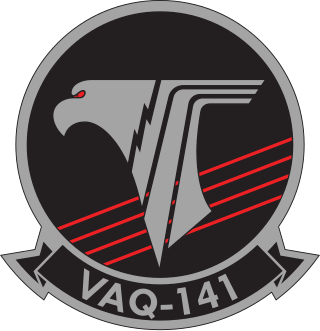
Electromagnetic Attack Squadron 141 (VAQ-141), also known as the "Shadowhawks", is an EA-18G Growler squadron of the United States Navy that is based at Marine Corps Air Station Iwakuni, located in Iwakuni, Yamaguchi, Japan. VAQ-141 falls under the cognizance of Commander, Electromagnetic Attack Wing Pacific (COMVAQWINGPAC) and flies in support of Carrier Air Wing 5 (CVW-5) aboard the Nimitz-class aircraft carrier, USS Ronald Reagan (CVN-76).

Electronic Attack Squadron 138 (VAQ-138), also known as the "Yellow Jackets", is an expeditionary EA-18G Growler squadron of the United States Navy based at Naval Air Station Whidbey Island, Washington.

Marine Composite Reconnaissance Squadron 1 (VMCJ-1) was an aviation squadron of the United States Marine Corps that provided aerial photographic reconnaissance and electronic countermeasures is support of the Fleet Marine Force. The squadron was formed in 1958 with the merger of Marine Composite Squadron 1 (VMC-1) and Marine Photo Reconnaissance 1 (VMJ-1). The squadron's support to the Vietnam War began in 1964 flying off Yankee Station and ended with sorties in support of Operation Frequent Wind during the fall of Saigon. VMCJ-1 was decommissioned in 1975 as the Marine Corps further consolidated its aerial photo reconnaissance assets after the Vietnam War.
Marine Air Traffic Control Units (MATCU) were United States Marine Corps air traffic control (ATC) detachments that provided continuous, all-weather, radar and non-radar, approach, departure, enroute, and tower ATC services at both garrison Marine Corps Air Stations and tactical airfields when deployed. MATCUs possessed Tactical air navigation systems (TACAN) and Ground-controlled approach (GCA) equipment which assisted Marine Corps, joint and coalition aircraft in conducting landings during inclement weather. During the Vietnam War, numerous MATCUs served throughout the I Corps Tactical region of South Vietnam supporting the III Marine Amphibious Force. Beginning in the mid-1970s, the Marine Corps decided to consolidate regionally aligned MATCUs into Marine Air Traffic Control Squadrons. The last reserve MATCU was decommissioned in 1980.





















